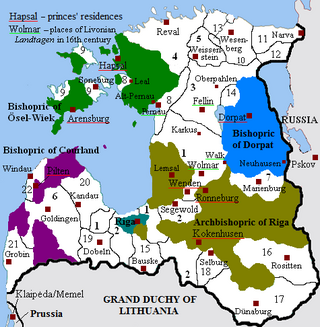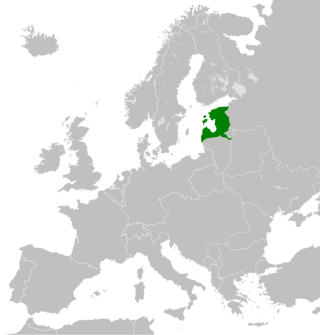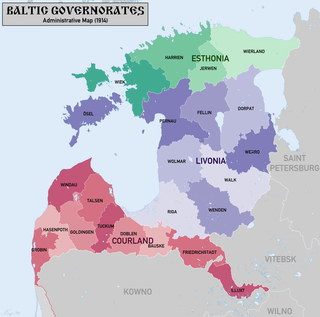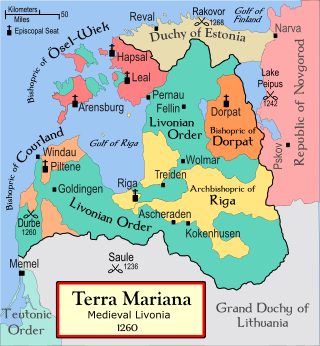
The history of Latvia began around 9000 BC with the end of the last glacial period in northern Europe. Ancient Baltic peoples arrived in the area during the second millennium BC, and four distinct tribal realms in Latvia's territory were identifiable towards the end of the first millennium AD. Latvia's principal river Daugava, was at the head of an important trade route from the Baltic region through Russia into southern Europe and the Middle East that was used by the Vikings and later Nordic and German traders.

Livonia or in earlier records Livland, is a historical region on the eastern shores of the Baltic Sea. It is named after the Livonians, who lived on the shores of present-day Latvia.

Baltic Germans are ethnic German inhabitants of the eastern shores of the Baltic Sea, in what today are Estonia and Latvia. Since their resettlement in 1945 after the end of World War II, Baltic Germans have markedly declined as a geographically determined ethnic group in the region.

Courland is one of the Historical Latvian Lands in western Latvia. Courland's largest city is Liepāja, which is the third largest city in Latvia. The regions of Semigallia and Selonia are sometimes considered as part of Courland as they were formerly held by the same duke.

The United Baltic Duchy, or alternatively the Grand Duchy of Livonia, was the name of a short-lived state during World War I that was proclaimed by leaders of the local Baltic German nobility.

The Duchy of Courland and Semigallia was a duchy in the Baltic region, then known as Livonia, that existed from 1561 to 1569 as a nominally vassal state of the Grand Duchy of Lithuania and subsequently made part of the Crown of the Polish Kingdom from 1569 to 1726 and incorporated into the Polish–Lithuanian Commonwealth in 1726. On March 28, 1795, it was annexed by the Russian Empire in the Third Partition of Poland.

The Baltic governorates, originally the Ostsee governorates, was a collective name for the administrative units of the Russian Empire set up in the territories of Swedish Estonia, Swedish Livonia (1721) and, afterwards, of the Duchy of Courland and Semigallia (1795).

Historical Latvian Lands or formerly Cultural regions of Latvia are several areas within Latvia formally recognised as distinct from the rest of the country. These are: Kurzeme (Courland), Zemgale, Latgale, Vidzeme, and Sēlija (Selonia). While some of these regions are seen purely as culturally distinct, others have historically been parts of different countries and have been used to divide the country for administrative and other purposes.

Gotthard Kettler, Duke of Courland was the last Master of the Livonian Order and the first Duke of Courland and Semigallia.

Baltic German nobility was a privileged social class in the territories of today's Estonia and Latvia. It has existed continuously since the Northern Crusades and the medieval foundation of Terra Mariana. Most of the nobility were Baltic Germans, but with the changing political landscape over the centuries, Polish, Swedish and Russian families also became part of the nobility, just as Baltic German families re-settled in locations such as the Swedish and Russian Empires. The nobility of Lithuania is for historical, social and ethnic reasons separated from the German-dominated nobility of Estonia and Latvia.

After 1918, the term Freikorps was used for the anti-communist paramilitary organizations that sprang up around the German Empire and the Baltics, as soldiers returned in defeat from World War I. It was one of the many Weimar paramilitary groups active during that time.

Courland Governorate, also known as the Province of Courland or Governorate of Kurland, and known from 1795 to 1796 as the Viceroyalty of Courland, was an administrative-territorial unit (guberniya) and one of the Baltic governorates of the Russian Empire. Its area roughly corresponded to parts of modern-day Latvia.

The Bishopric of Courland was the second smallest (4500 km2) ecclesiastical state in the Livonian Confederation founded in the aftermath of the Livonian Crusade. During the Livonian War in 1559 the bishopric became a possession of Denmark, and in 1585 sold by Denmark to Poland–Lithuania.

Estonia was under military occupation by the German Empire during the later stages of the First World War. On 11–21 October 1917, the Imperial German Army occupied the West Estonian archipelago, including the larger islands of Saaremaa (Ösel), Hiiumaa (Dagö), and Muhu (Moon).

Aizupe Manor is a manor house built in late classicism style in Vāne Parish, Tukums Municipality, in the Courland region of Latvia. Construction of the manor was completed in 1823. The building housed a forestry school from 1939 to 1985.

The flag of the Livonians is a flag used to symbolize the Livonian people. It is in use of various Livonian cultural groups. The flag's proportions are 2:1:2 and the ratio of the height of the flag to its width is fixed at 1:2, similarly to the Flag of Latvia.

The Treaty of Vilnius or Vilna was concluded on 28 November 1561, during the Livonian War, between the Livonian Confederation and the Grand Duchy of Lithuania in Vilnius. With the treaty, the non-Danish and non-Swedish part of Livonia, with the exception of the Free imperial city of Riga, subjected itself to the Grand Duke of Lithuania, Sigismund II Augustus with the Pacta subiectionis (Provisio ducalis). In turn, Sigismund granted protection from the Tsardom of Russia and confirmed the Livonian estates' traditional privileges, laid out in the Privilegium Sigismundi Augusti.

Terra Mariana was the formal name for Medieval Livonia or Old Livonia. It was formed in the aftermath of the Livonian Crusade, and its territories were composed of present-day Estonia and Latvia. It was established on 2 February 1207, as a principality of the Holy Roman Empire, and lost this status in 1215 when Pope Innocent III proclaimed it as directly subject to the Holy See.
Courland is one of the historical and cultural regions of Latvia.
Livonian Peasants' Laws were laws introduced in the 19th century for Governorate of Livonia of the Russian Empire. About the same time similar laws has been enacted in all Baltic governorates and Duchy of Courland and Semigallia. These laws changed and clarified peasants rights and obligations, who ethnically were mainly Estonians and Latvians. This development culminated in Peasant Community Code of 1866 which codified peasants self-governance.


















